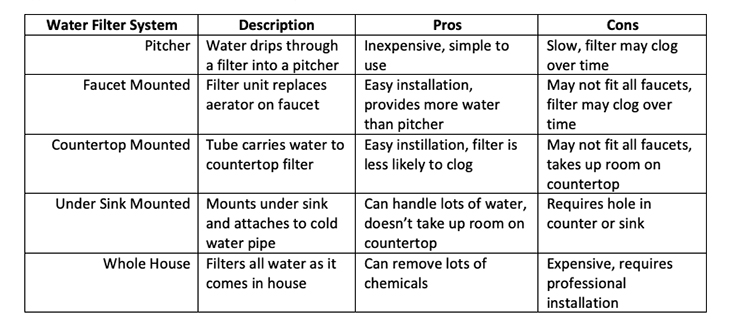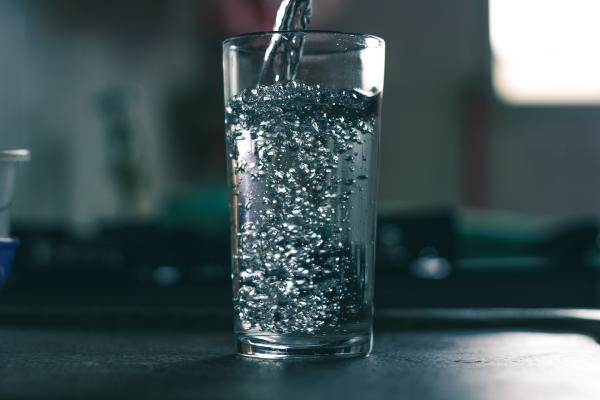One survey (by a water filtration company) estimated that approximately 77% of the US uses an in-home water filtration system. The $5.85 billion US water purifier market (in 2021) is expected to grow annually. Since such a large percentage of Americans use water filters [1], more attention must be paid to the health problems that can occur from not changing those filters.
Types of Home Water Filter Systems
 The first four systems are considered point-of-use treatment systems since they treat water in batches and deliver it to a single tap. In contrast, the whole house system is considered a point-of-entry treatment system, typically treating most of the water entering a home.
The first four systems are considered point-of-use treatment systems since they treat water in batches and deliver it to a single tap. In contrast, the whole house system is considered a point-of-entry treatment system, typically treating most of the water entering a home.
Do you Need a Water Filter?
Most people buy a water filter because of taste or odor concerns or because they are worried it may contain chemicals, such as lead, that are hazardous to their health.
The first step to deciding if you need a water filter is to find your drinking water source. If your drinking water comes from a medium to large public water system, you most likely do not need a water filter. As I previously wrote, most medium to large water systems have done a good job meeting the EPA drinking water regulations. Most problems with drinking water occur in small water systems and private wells.
If you are having taste or odor problems with your drinking water, is the problem with your household plumbing or your water utility? If the problem only occurs in certain faucets, it is likely in your household plumbing; if it occurs throughout the home, it is probably from your water utility – contact them or your local public health agency.
The good news is that these taste and odor problems do not usually cause health problems. However, nobody likes to drink water that tastes or smells bad, and a water filter can be very helpful in solving these issues.
Some of the most common taste and odor problems in drinking water are:
- metallic taste – usually caused by iron or copper leaching from the pipes
- chlorine or “chemical” taste or odor - usually an interaction of chlorine with organic matter in your plumbing system
- sulfur or rotten egg odor – usually from naturally occurring hydrogen sulfide found in groundwater
- moldy or fishy odor – usually caused by bacteria growing in your sink drain or plants, animals, or bacteria naturally found in lakes and reservoirs
- salty taste – usually caused by high levels of naturally occurring sodium, magnesium, or potassium.
The second reason people buy water filters is because of fear of hazardous chemicals. Although EPA regulates 90 contaminants in public water systems, many people do not trust that their water is safe to drink without a water filter. A survey reported that people filtered their water believing it was healthier (42%) or more environmentally friendly (41%) or they didn’t trust the quality of their water (37%).
Health Issues
Unchanged water filters can bring about more health problems than they solve
This happens because harmful bacteria and other microbes can grow and breed when filters are not changed regularly. As filters become blocked, they can break down, creating a backlog of bacteria and chemicals that can enter your home water. The overgrowth of harmful bacteria can be harmful to your health, causing gastrointestinal problems, including vomiting and diarrhea.
Water filters remove both good and bad chemicals
Water filters cannot distinguish between chemicals that are essential for good health, such as calcium, magnesium, iodine, and potassium, and those that are harmful, such as lead and cadmium.
This is because removing chemicals with water filters is based on the pore size of the filters, the size of the tiny holes that let water through. Imagine a strainer or colander. The smaller the pores, the smaller the contaminants they keep out. For example, an activated carbon filter with a microfiltration filter has a pore size of approximately 0.1 microns [2]; a reverse osmosis filter has a pore size of about 0.0001 microns, keeping out smaller size chemicals than the carbon filter.
Filters will keep out all chemicals of similar size, whether they are essential for good health or hazardous. This has become an issue in countries such as Israel, which extensively use desalination for their drinking water. Desalination uses a reverse-osmosis system to remove salt from the water, but along with salt, it also removes four essential elements: fluoride, calcium, iodine, and magnesium. There is particular concern in Israel with iodine deficiency, which can cause thyroid dysfunction, and magnesium deficiency, linked to heart problems and type 2 diabetes, in the population due to the widespread use of desalination.
What is a consumer to do?
There is no one answer as to whether you should buy a water filter. This is a personal choice dependent on the specifics of your home situation. The most important issues when investigating home water filters are the filter type, pore size, and the specific contaminants removed.
The major types of water filters are:
- Activated Carbon – is the most common type because of its low cost and high adsorption rate. Suitable for removing lead, mercury, and chlorine, but it does not remove nitrate, arsenic, heavy metals, or many bacteria.
- Reverse Osmosis – uses pressure to remove impurities through semi-permeable membranes. Good at removing many chemicals and bacteria.
- Ultrafiltration – similar to reverse osmosis but doesn’t require energy to work. It removes more chemicals than reverse osmosis.
- Water Distillation – heats water to the boiling point and then collects the water vapor as it condenses. Suitable for removing most chemicals and bacteria.
- Ion Exchange Filters – use a resin that contains positively charged hydrogen ions that attract contaminants—used for water softening (removes calcium, magnesium, and other minerals from water and replaces them with sodium).
- Ultraviolet Radiation – high-intensity light removes bacteria but does not remove chemicals.
If you are thinking about buying a water filter, there are some excellent resources available:
- For general information, the CDC website
- For information about different types of water filters
- Product ratings
- Product certification by the National Sanitation Foundation (NSF), an independent organization that develops public health standards for products
If you buy a water filter or have an existing unit, please remember to change the filter!
[1] I use the term “water filter” to refer to any device that removes contaminants from water.
[2] A micron is equal to a millionth of a meter; a human hair is approximately 70 microns




